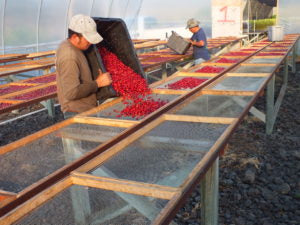Is Your Coffee Too Fresh?
Coffee bags are often labeled “fresh” or “fresh roasted.” However, the labels are meaningless since there is no definition for “fresh” coffee. One retailer’s definition may be days after roasting and another retailer’s definition months after roasting. For example, the “sell by date” on coffee bags labeled “fresh” in the supermarket is typically 9 months after roasting.
There are two dates that gourmet coffee drinkers need to know (1) the date the beans were picked and (2) the date the beans were roasted. It can be difficult to discover those dates. Asking a coffee shop barista when their coffee was picked or even when it was roasted is a waste of time. Baristas have no idea when the coffee they brew was picked and usually don’t even know when it was roasted.
Picking Date
Coffee fruit is seasonal. In most areas coffee fruit flowers and matures for about six months of every year. Since not all the flowers emerge at the same time, ripe coffee picking occurs over a six month period. So, in the true sense of the word, “fresh” coffee beans would be beans from the current picking season.
A phase associated with fresh picked coffee is “current crop year.” In other words, there are no other beans available that are younger than the beans in the coffee you are drinking. It is difficult for consumers to tell if the coffee they are drinking is the newest available. Coffee mills sometimes stockpile coffee during good years and hold it over for later years. Distributors in foreign countries do the same thing and so do American distributors and roasters. When you buy a coffee, you can’t assume that it was picked within the current crop year. There are cases where green coffee has been held in storage for as long as 30 years before being roasted. If the coffee tastes flat, or woody, or like burlap it is probably past crop coffee.
Consumers who want “fresh” green coffee beans need to set up a farm direct relationship. Only the farmer who grew and processed the beans knows when they were picked and how they were stored. Farm direct reduces the time between the farm and the end user. It also provides transparency that can be passed on to the consumer. Find out if the farmer is passionate about her coffee and is transparent about picking and processing methods. Then enjoy coffee that is as good as it is going to get. Hula Daddy only roasts coffee from the current crop year.
Roast Date
There is a myth that coffee should be brewed as close to the roast date as possible. However, after roasting, coffee beans go through a process called degassing. During roasting, carbon dioxide (CO2) is produced within the beans. This CO2 needs time to escape before the coffee can be brewed. If you brew coffee immediately after roasting, you end up with a brew that tastes overly acidic and somewhat flat.
In the first few days after roasting, the coffee undergoes what’s known as the “resting period.” During this time, the flavors develop and stabilize, allowing the coffee to reach its peak taste. Many coffee aficionados believe that waiting for at least 3 days after roasting allows the coffee to mature and fully express its flavors. However, there is no fixed rule about how many days to wait after roasting. The consensus is that coffee should be brewed within 3 to 14 days after roasting. However, the ideal time frame can vary depending on personal preferences, roast level, and the type of brewing method used.
After the flavor peaks the beans begin to slowly degrade. Old coffee doesn’t taste bad, it just tastes flat, like restaurant coffee.
One test for fresh roasted coffee is to watch for the “bloom.” When hot water is poured on ground fresh roasted coffee the CO2 in the grounds escapes and the slurry rises up. If your coffee stays flat when you pour hot water on it, it was roasted a long time ago.
To ensure you’re getting the best out of your freshly roasted coffee, here are a few tips to keep in mind:
· Buy direct from the roaster.
· Only buy coffee that has the roast date on it.
· Wait to brew until after the resting period.
Remember, the art of brewing coffee is as much science as it is personal preference. While the recommended time frame for brewing fresh roasted coffee falls within 3 to 14 days after roasting, don’t be afraid to experiment and find the sweet spot that satisfies your taste buds.
Hula Daddy puts the roast date on every bag of coffee.
Bon Appetit

